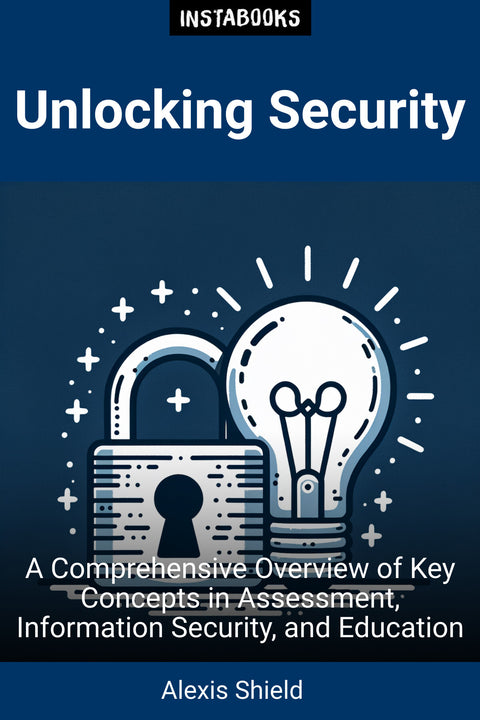
Unlocking Security
A Comprehensive Overview of Key Concepts in Assessment, Information Security, and Education
Included:
✓ 200+ Page AI-Generated Book
✓ ePub eBook File — read on Kindle & Apple Books
✓ PDF Print File (Easy Printing)
✓ Word DOCX File (Easy Editing)
✓ Hi-Res Print-Ready Book Cover (No Logo Watermark)
✓ Full Commercial Use Rights — keep 100% of royalties
✓ Publish under your own Author Name
✓ Sell on Amazon KDP, IngramSpark, Lulu, Blurb & Gumroad to millions of readers worldwide
Introduction to Information Security
In a digital world, understanding the key concepts of information security is more crucial than ever. This book is designed to provide readers with a comprehensive overview of the fundamental principles that govern the fields of assessment, information security, and education. We aim to distill complex ideas into clear teachings that empower readers to grasp the essential themes without the clutter of extraneous details.
The CIA Triad and Its Importance
The CIA Triad—Confidentiality, Integrity, and Availability—is the cornerstone of information security. This section explains why these three components are vital in safeguarding sensitive data and maintaining the trust of users. With real-world applications and easy-to-understand language, readers will appreciate how these principles apply to everyday practices in their organizations.
Risk Management Essentials
Learn how to effectively assess and prioritize risks in various contexts. This chapter guides students through strategies for mitigating potential threats using appropriate risk response techniques. It offers actionable insights into how organizations can protect their assets while adapting to the ever-changing landscape of cybersecurity.
Implementing Security Controls
This section delves into security controls, breaking them down into physical, technical, and administrative categories. Detailed examples and helpful frameworks will illustrate how to safeguard information systems effectively using layered approaches and comprehensive policies.
The Role of Governance in Security
Explore how governance structures shape organizational security strategies. Understanding policies, standards, and governance not only enhances decision-making but ensures that information security practices align with organizational goals.
Ethics and Professional Behavior
Adhering to ethical guidelines in information security is essential. This chapter discusses the ISC2 Code of Ethics and its implications for professionals in the field. By understanding their responsibility, readers are equipped to navigate the ethical dilemmas they may encounter.
Incident Response and Real-time Monitoring
Incident management is a critical aspect of information security. This section highlights techniques and tools for real-time monitoring of networks to effectively respond to cybersecurity events, ensuring swift action is taken to mitigate any harm.
Layering Security for Best Practices
This chapter discusses the methodology of layering security measures to enhance protection. Readers will learn about combining multiple security mechanisms, such as multi-factor authentication and remote browser isolation, to safeguard data and resources effectively.
Data Validation and Change Control
Understanding how to implement data validation checks is vital for preventing unauthorized access or alterations. This chapter elaborates on best practices for change control processes, ensuring that any modifications to data are documented and authorized.
Non-Repudiation in Communication
Non-repudiation is essential for maintaining integrity in communication. This section explores how proving actions and messages can help mitigate disputes and enhance trust in relationships.
Modern Security Frameworks and Compliance
This book concludes with an overview of comprehensive security frameworks such as NIST and ISO 27001. By incorporating these broader principles, readers gain a nuanced understanding of how these frameworks aid in risk management, user awareness, and regulatory compliance practices.
Conclusion: Building a Foundation
By understanding these key concepts and principles, readers will build a solid foundation in information security, preparing them for deeper exploration into their areas of interest and enhancing their professional growth in cybersecurity fields.
Table of Contents
1. Understanding the CIA Triad- Confidentiality: Protecting Sensitive Information
- Integrity: Ensuring Data Accuracy
- Availability: Access When Needed
2. Risk Management Fundamentals
- Assessing Organizational Risks
- Prioritizing Risks and Responses
- Mitigation Strategies for Threats
3. Overview of Security Controls
- Physical Controls: Staying Protected
- Technical Controls: Using Technology for Safety
- Administrative Controls: Policies that Secure Data
4. Organizational Governance in Security
- Policies and Standards Overview
- Driving Decision-making through Governance
- Aligning Security with Business Objectives
5. Ethics in Information Security
- Understanding the ISC2 Code of Ethics
- Professional Behavior and Responsibilities
- Navigating Ethical Dilemmas in Practice
6. Incident Management Strategies
- Real-Time Monitoring Techniques
- Detecting Cybersecurity Events
- Managing Incidents Effectively
7. Layering Security Measures
- Importance of Multi-Layered Security
- Best Practices for Layered Protection
- Challenges in Implementing Layers
8. Implementing Data Validation
- Significance of Data Validation
- Preventing Unauthorized Changes
- Authorizing Changes through Control
9. The Concept of Non-Repudiation
- Essentials of Non-Repudiation
- Tools for Non-Repudiation
- Implications for Legal and Ethical Communication
10. Exploring Comprehensive Security Frameworks
- Introduction to NIST Cybersecurity Framework
- Understanding ISO 27001
- Aligning Frameworks with Organizational Needs
11. Building a Solid Foundation for Further Study
- Recap of Key Concepts Covered
- Available Resources for Continued Learning
- Preparing for Deeper Exploration in Fields of Interest
12. Future Trends in Information Security
- Emerging Technologies and Risks
- The Impact of AI on Cybersecurity
- Preparing for Tomorrow's Challenges
Target Audience
This book is aimed at students, educators, and professionals seeking to build essential knowledge in information security and assessment, paving the way for deeper exploration in their fields.
Key Takeaways
- Understanding key information security concepts: CIA triad, risk management, security controls.
- Gaining insights into the governance of security practices.
- Exploring ethical considerations and incident management strategies.
- Learning to implement data validation and change control processes.
- Familiarizing with modern security frameworks and future trends in cybersecurity.
